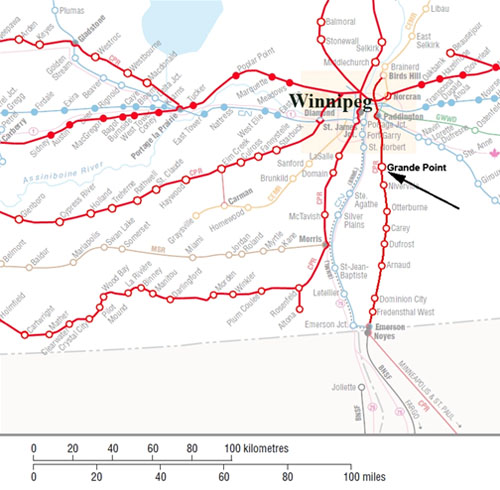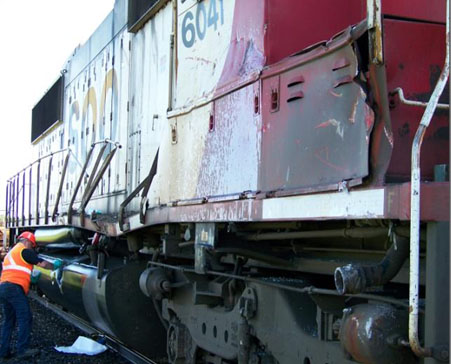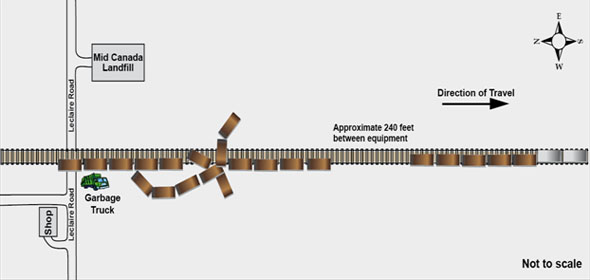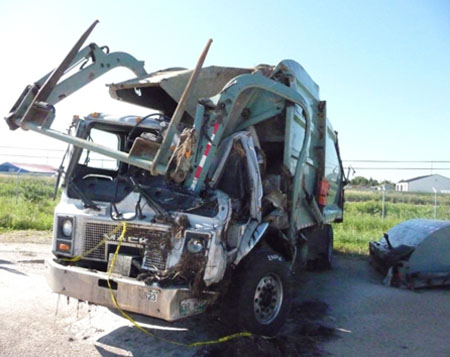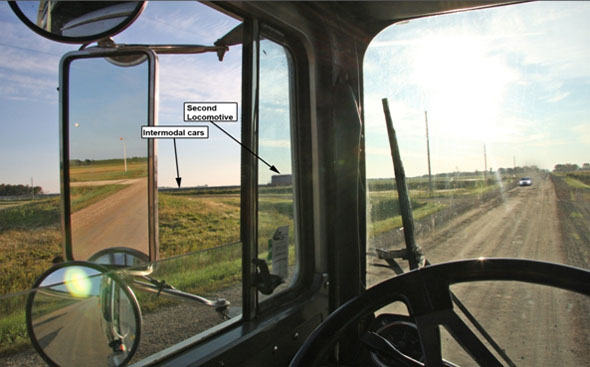Crossing accident
Canadian Pacific Railway
Freight train no. 290-14
Mile 13.85, Emerson Subdivision
Grande Pointe, Manitoba
The Transportation Safety Board of Canada (TSB) investigated this occurrence for the purpose of advancing transportation safety. It is not the function of the Board to assign fault or determine civil or criminal liability. This report is not created for use in the context of legal, disciplinary or other proceedings. See Ownership and use of content. Masculine pronouns and position titles may be used to signify all genders to comply with the Canadian Transportation Accident Investigation and Safety Board Act (S.C. 1989, c. 3).
Summary
At about 0700 Central Daylight Time on 14 June 2010, Canadian Pacific Railway freight train 290-14 was proceeding southward at 25 mph on the Emerson Subdivision when it was struck by an eastbound garbage truck travelling at a speed of at least 60 km/h, as the train occupied the passive crossing at Mile 13.85, near Grande Pointe, Manitoba. As a result of the collision, 22 car bodies derailed and the fuel tank on the second locomotive was punctured releasing about 4,000 gallons of diesel fuel. The garbage truck was destroyed and the driver was seriously injured.
Ce rapport est également disponible en français.
Factual information
On 14 June 2010, at about 0630,Footnote 1 Canadian Pacific Railway (CPR) freight train 290-14 (the train) departed Winnipeg and proceeded southward on the Emerson Subdivision, destined for the United States border near Emerson, Manitoba (see Figure 1). The train was powered by 2 head-end locomotives hauling 86 cars (60 loads and 26 empties). The first 18 car bodies behind the locomotives were empty intermodal cars. The train was approximately 6073 feet long and weighed about 8602 tons. The train received a full mechanical inspection and air brake test prior to departure, with no exceptions noted. The crew comprised a locomotive engineer and conductor who were both familiar with the subdivision, met fitness and rest standards, and were qualified for their respective positions.
The accident
At approximately 0700, the train approached the Leclaire Road crossing at Mile 13.85 with the ditch lights on and head lights on full power. The crew applied a short horn at the whistle post, about ¼ mile north of the crossing, and then observed a car heading towards the crossing from the east and a garbage truck (the truck) approaching from the west. The initial horn was followed by a second short horn after which the crew observed the car traverse the crossing, about 4 seconds prior to the train occupying the crossing. The crew applied a third short burst of horn just prior to the crossing and a long burst of horn as the train occupied the crossing.
As the truck did not appear to be slowing down, the crew braced for impact. Following impact, the crew applied a full service brake application to bring the train to a controlled stop. Approximately 25 seconds later, the train experienced an undesired emergency brake application (UDE) and the head-end came to a stop about 1600 feet south of the crossing at Mile 14.05. Subsequent inspection determined that the truck had struck the second locomotive in the consist, SOO 6041 (see Photo 1). The locomotive was not derailed but its fuel tank was punctured, releasing about 4000 gallons of fuel. The first 22 car bodies behind the locomotives had derailed.
The truck driver (the driver), who was not wearing a seatbelt, was thrown from the truck and sustained serious injuries. Police, fire, and emergency medical personnel responded to the accident. The driver was transported and admitted to hospital. The train crew was uninjured.
The weather at the time of the occurrence was sunny, 12°C, and the winds were calm. The sun was low in the eastern sky, approximately 14 degrees above the horizon.
Truck and driver information
The 2007 Mack garbage truck was owned and operated by Johnson Waste Management. The truck was approximately 30 feet long and had a tare weight of 16,170 pounds. The truck was regularly maintained and in good mechanical condition, having passed a Manitoba safety inspection within 2 weeks prior to the accident. Its standard equipment included an event data recorder (EDR). This EDR has limited recording abilities and was not specifically designed for use in accident investigations. The EDR was recovered and sent to the TSB Laboratory for analysis.
The driver had over 20 years of experience as a commercial truck driver and had been employed by the company for the last 2 years. The driver held a valid commercial truck licence and was authorized to operate this type of vehicle. He was required to wear glasses for driving, had an up-to-date prescription, and was wearing them. The driver regularly used this crossing during work hours. Between 0400 and 1300, Monday to Friday, the driver traversed the crossing an average of 5 times a day while travelling to the Mid-Canada landfill. During this time, the driver had never observed a train in the area of the crossing and assumed that the rail line had been abandoned.
On the day of the accident, the driver began his work day at the usual time. He completed his first collection and the truck was fully loaded as it headed eastward on Leclaire Road towards the landfill. The radio was on low and the windows were rolled up. The truck was travelling at a speed of at least 60 km/h as it approached the crossing. Due to the narrow width of the 2-lane gravel road, the driver had to manoeuvre to avoid an oncoming car. The 2 vehicles passed each other approximately 75 metres west of the crossing, with the sun on the horizon in his field of vision. The driver was not wearing sunglasses. Approximately 10 to 15 metres before the crossing, the driver observed the train, applied the brakes and swerved the truck to the right (south) before contacting the second locomotive. The truck was pushed into the ditch, where it overturned and came to rest southwest of the crossing.
Site examination
The right (west) side of locomotive SOO 6041 sustained impact damage (see Photo 1). The right front step sill and grab iron were damaged and there was a large dent near the mid-point of the locomotive frame and fuel tank. The first 5 car bodies behind the locomotives derailed upright, straddling the west rail. This was followed by a gap of about 240 feet which led up to an additional 17 car bodies that had derailed in various positions (see Figure 2).
Approximately 10 feet north of the crossing, wheel marks were observed along the web of the east rail, extending southward into the crossing. The crossing and about 520 feet of track to the south were destroyed and an additional 500 feet of track further south was damaged. Beyond the destroyed track, wheel impact marks were observed between the rails, and just west of the west rail, on the ties leading up to the point where the locomotives came to rest.
The truck was essentially destroyed (see Photo 2). The front driver side of the cab was crushed and the bottom corner of the driver side rear tail gate was damaged. Gouges, scrapes and black paint marks were observed on both the front and rear of the truck.
Emerson Subdivision and track information
The Emerson Subdivision consists of a single main track which starts in Winnipeg and extends 64 miles south to the international border. The track at the crossing was tangent, with a level grade, and consisted of 115-pound continuously welded rail. Track components were in good condition and met the requirements of Track Safety Rules approved by Transport Canada (TC).
The method of train control is the Occupancy Control System (OCS) authorized by the Canadian Rail Operating Rules (CROR) and supervised by a rail traffic controller (RTC) located in Calgary, Alberta. Maximum subdivision speed is 40 mph. However, there was a slow order in place from Mile 10 to Mile 44 restricting speed to 25 mph due to track surface conditions. An average of 4 trains per day pass on the subdivision.
Crossing and road information
Leclaire Road is a 2-lane gravel road (approximately 25 feet wide) that crosses the Emerson Subdivision at a 90-degree angle. The road ascends at 2% as it nears the crossing from the west. The posted road speed is 90 km/h in the vicinity of the crossing. Weekday traffic (based on a 2008 traffic survey) averaged 820 vehicles per day. Advanced warning signs are posted about 500 feet on each side of the crossing. The crossing is a passive crossing, equipped with standard railway cross buck signs. TC last inspected the crossing on 09 November 2005, with no exceptions noted. Based on reportable occurrences, there was one previous accident at this crossing, in 1986, with no injuries reported.
On the north side of Leclaire Road and west of the crossing, there is a large building which was constructed in 2008. The building partially obstructs the visibility of the rail line to the north for drivers approaching from the west.
Canadian Rail Operating Rule 14
CROR Rule 14 governs the use of locomotive horn signals. Section (L) indicates that the train horn must be blown using 2 long, 1 short, and 1 long succession of sounds at every whistle post. The rule states (in part):
Movements operating at 44 mph or less must sound whistle signal to provide 20 seconds warning before entering the crossing and continuing to sound whistle signal until crossing is fully occupied.
Train horn audibility
Section 11.2 of TC's Railway Locomotive Inspection and Safety Rules, as revised 04 February 2010, state that "all locomotives other than in designated service operating in a controlling position shall be equipped with:
- a horn capable of producing a minimum sound level of 96 dB(A) at any location on an arc of 30 meters (100 feet) radius subtended forward of the locomotive by angles 45 degrees to the left and to the right of the centerline of the track in the direction of travel."
A Transportation Development Centre studyFootnote 2 evaluating locomotive horn effectiveness determined that audible warnings should be at least 10 dB(A) above ambient noise to be recognizable as an auditory danger signal.
TSB Simulation of Crossing Accident
An on-site simulation of the crossing accident was conducted using a similar CP train and an identical truck. The simulation and related field measurements determined that:
- The measured sightlines met the TC Minimum Railway/Road Crossing Sightline Requirements For All Grade Crossings Without Automatic Warning Devices (G4-A).
- The average ambient noise in the truck cab driving on the gravel road without the radio playing was in excess of 95 dB(A).
- The pillar between the truck's windshield and side window, the side mirrors and window frame obstructed the driver's field of view to the north (see Photo 3).
- With the position of the sun at the time of the accident, the empty intermodal cars at the head-end of the train blended into the background which made it difficult to distinguish the train from other features on the horizon.
TSB Laboratory analysis
The TSB Laboratory conducted an analysis of the LER data and reviewed a Train Operations and Energy Simulator (TOES) train dynamics simulation performed by CPR. The following is a summary of observations and analysis:
- After the UDE, the train travelled about 270 feet before stopping at Mile 14.05. This distance was similar to the separation distance between the 5th and 6th derailed cars.
- The TOES simulation determined that train handling after the collision was not considered to be a cause or contributing factor for the derailment.
- The in-train forces resulting from the service brake application and subsequent UDE were low to moderate and not considered sufficient to cause a derailment.
An analysis of the recovered truck EDR was also conducted. The following is a summary of observations and analysis:
- The EDR stores up to 16 seconds of data initiated by the vehicle's last stop. Data capture is initiated from a sensed vehicle speed of 0.5 mph or less. The EDR may record the vehicle speed, engine speed, brake application, engine brake engaged, cruise control, clutch (if applicable), and ignition switch position. The EDR has no accelerometer inputs and does not record force.
- EDR data is transferred to the non-volatile memory when the parking brake switch transitions from "OFF" to "ON" This parking brake transition must occur before power to the recorder is interrupted. The recorder's internal clock is powered directly from the vehicle's battery, however the unit receives its power through the ignition switch. If the vehicle is turned off or power to the vehicle is lost prior to the memory being transferred, then the data will be lost. These conditions for the memory transfer are specific for the combination of hardware and software versions present in the occurrence unit.
- In this occurrence, since the truck's parking brake had not been applied prior to the loss of power to the EDR, the occurrence data was not written to the unit. Consequently, there was no data available.
Related previous TSB investigations
On 09 November 1999, at approximately 0900 Eastern Standard Time, VIA Rail Canada Inc. passenger train No. 85, travelling westward on the main track of the Goderich Exeter Railway Guelph Subdivision, collided with a dump truck heading north on Fourth Line Road in the community of Limehouse, Ontario. Upon impact, the locomotive and four passenger coaches derailed to the north of the main track. (R99S0100)
On 30 August 2000, at approximately 1400 Eastern Daylight Time, VIA Rail Canada Inc. train No. 603 was travelling westward from Hervey, Quebec. As the train approached the station at La Tuque, Quebec, it collided with a dump truck that was on the private crossing at Mile 119.35 of the La Tuque Subdivision. The truck driver lost his life in the accident. The locomotive and three cars of train No. 603 derailed. The truck was destroyed and the diesel fuel spilled and caught fire (R00D0098).
On 09 August 2001, eastward Canadian Pacific train 218, travelling at 38 mph, struck a loaded tractor-trailer travelling southward at the crossing at Mile 122.71 of the Indian Head Subdivision, near Moose Jaw, Saskatchewan. The collision resulted in both locomotives and 13 cars of the train derailing and blocking the main track. The tractor, a 1999 Mack truck, and trailer were destroyed (R01W0149).
Each of these investigations determined that a large portion of the view along the railway line was obstructed by the roof pillar and side mirror on either the driver or passenger side of the truck cab and may have hindered the ability of the truck driver to see the approaching train.
Analysis
Neither train handling nor track or equipment condition was considered to be contributory to the accident. Therefore, the analysis will focus on driver behaviour, driver perceptions and train horn audibility.
The accident
The train approached the crossing from the north with the headlights, ditch lights, and horn all in use. The truck proceeded at a speed of at least 60 km/h with the driver unaware of, and not looking for, the approaching train. As the train entered the crossing, the driver became aware of the imminent collision and took evasive action. The collision occurred when the truck was unable to stop before impacting the second locomotive (i.e., west side of SOO 6041). The impact pushed the locomotive eastward but did not derail it. However, the force of the impact canted the east rail eastward which allowed the lead wheels of the first car behind the locomotive to drop into gauge, about 10 feet north of the crossing, causing the derailment.
Following the impact of the truck, the crew made a service air brake application and 25 seconds later the train experienced a UDE. After the UDE, the train travelled about 270 feet before stopping. The train stopping distance was similar to the distance separating the 5th and 6th derailed cars; therefore, the UDE was triggered by the train separation, rather than the truck impact.
Driver expectation
Advance warning and passive crossing signs do not alert drivers to the presence of a train, but only to the presence of a roadway crossing over a track upon which a train may be operating. The responsibility is on the driver to verify if a train is present or approaching and determine the need to stop.Footnote 3 If drivers do not believe or verify that there are trains actively using the railway tracks, the presence of advance warning and standard railway crossing signs are not always an effective defence.
Approaching the crossing, the driver's attention was initially focused on navigating past the oncoming car. The truck was a wide vehicle which required the driver's full visual and cognitive attention when passing the oncoming vehicle on the narrow, gravel road. When focused on a demanding task, people are less likely to perceive other cues from the environment, such as a faint audible alarm or a visible peripheral silhouette. Vehicle drivers also take cues from other vehicles. Since the oncoming car did not stop at the crossing, this likely provided a cue to the driver that it was safe to proceed. Furthermore, the driver regularly used this crossing yet had never encountered a train at this location, even though there were 4 trains per day. Based on experience, the driver believed that the track was abandoned and therefore had no expectation of encountering a train. The combination of the driver's focus on the oncoming vehicle and the expectation that there would not be a train at the crossing resulted in the driver not looking for, or noticing, the train until it was too late to avoid the collision.
Visibility of the train
The head-end of the train was marshalled with 2 locomotives followed by 18 empty intermodal cars. On the approach to the crossing, only the 2 locomotives would have visibly protruded above the line of the horizon while the empty cars were masked by the surrounding landscape, blending into the background. The sun was low on the horizon, slightly above and behind the 2 locomotives. The intensity of the sun and resulting glare would have forced the driver to move his point of focus to the right, away from the approaching train, making it even more difficult to see the locomotives. With the empty cars blending into the surrounding landscape, the position and intensity of the sun likely reduced the driver's ability to detect the presence of the train.
The presence of the building on the northwest corner of the crossing limited the amount of time that the driver had available to notice the train. Furthermore, similar to other TSB investigations, the TSB accident simulation determined that the pillar between the truck's windshield and side window, the large side mirrors and window frame obstructed the driver's field of view to the left. Similar arrangements are common on many North American trucks.
Train horn
Present regulatory requirements specify that a locomotive horn must be capable of producing a minimum sound level of 96 dB(A). However, the average ambient noise in the truck cab while driving on the gravel road without the radio playing was in excess of 95 dB(A). Therefore, the sound level of the locomotive horn would likely not exceed the ambient noise in the truck cab at a perceptible level. The locomotive horn was sounded as the train approached the crossing but not sounded in accordance with CROR 14. Regardless of how the horn was sounded, in this case, it likely would not have been audible in the truck cab. Even though a locomotive horn is a necessary line of defence at passive crossings, when vehicles have a high level of internal ambient noise, the locomotive horn is not always effective in warning vehicle drivers of an approaching train, increasing the risk of a crossing accident.
Truck Event Data Recorder
The truck's EDR only stores up to 16 seconds of data which is initiated from a sensed vehicle speed of 0.5 mph or less. This data is only transferred to the memory when the parking brake switch transitions from "OFF" to "ON." If the vehicle is turned off or power to the vehicle is lost, prior to the memory being transferred, then the data will be lost. When the accident occurred, the parking brake was not applied and power to the vehicle was lost. Consequently, the truck EDR contained no retrievable data and key information which would have assisted with the investigation was not available due to manufacturer settings in the recorder.
The following TSB Laboratory report was completed:
- LP096/2010 – Analysis of LER data and review of TOES simulation
- LP109/2010 – Analysis of truck record & brake module
Findings
Findings as to causes and contributing factors
- The collision occurred when the truck was unable to stop before striking the second locomotive.
- The force of the impact canted the east rail eastward which allowed the lead wheels of the first car behind the locomotive to drop into gauge, about 10 feet north of the crossing, causing the derailment.
- The combination of the driver's focus on the oncoming vehicle and his expectation that there would not be a train at the crossing resulted in the driver not looking for, or noticing, the train until it was too late to avoid the collision.
- With the empty cars blending into the surrounding landscape, the position and intensity of the sun likely reduced the driver's ability to detect the presence of the train.
- The presence of a structural pillar between the truck's windshield and side window, the large side mirrors and the window frame on the truck obstructed a large part of the driver's field of view to the left.
- The ambient noise in the truck cab deprived the driver of the warning provided by the locomotive horn.
Finding as to risk
- When vehicles have a high level of internal ambient noise, the locomotive horn is not always effective in warning vehicle drivers of an approaching train, increasing the risk of a crossing accident.
Other findings
- The train stopping distance was similar to the distance separating the 5th and 6th derailed cars; therefore, the undesired emergency brake application was triggered by the train separation, rather than the truck impact.
- The truck event data recorder contained no retrievable data and key information which would have assisted with the investigation was not available due to manufacturer settings in the recorder.
This report concludes the Transportation Safety Board's investigation into this occurrence. Consequently, the Board authorized the release of this report on .
